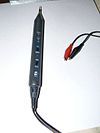- Logic probe
-
A logic probe is a hand-held pen-like test probe used for analyzing and troubleshooting the logical states (Boolean 0 or 1) of a digital circuit. While most are powered by the circuit under test, some devices use batteries. They can be used on either TTL (transistor-transistor logic) or CMOS (complementary metallic oxide semiconductor) integrated circuit devices.
There are usually three differently-colored LEDs on the probe's body:
- Red and green LEDs indicate high and low states respectively
- An amber LED indicates a pulse
The pulse-detecting electronics usually has a pulse-stretcher circuit so that even very short pulses become visible on the amber LED. A control on the logic probe allows either the capture and storage of a single event or continuous running.
When the logic probe is either connected to an invalid logic level (a fault condition or a tri-stated output) or not connected at all, none of the LEDs lights up.
Another control on the logic probe allow selection of either TTL or CMOS family logic. This is required as these families have different thresholds for VIH and VIL.
Some logic probes have a separate audible tone for each of the logical states. An oscillating signal causes the probe to alternate between high-state and low-state tones.
A logic probe is a cheap, versatile and convenient digital test instrument, but can test only a single signal at a time. When many logic levels need to be observed or recorded simultaneously, a logic analyzer is used.
External links
Categories:- Electronic test equipment
- Digital electronics
- Measuring instruments
- Electronics stubs
Wikimedia Foundation. 2010.

